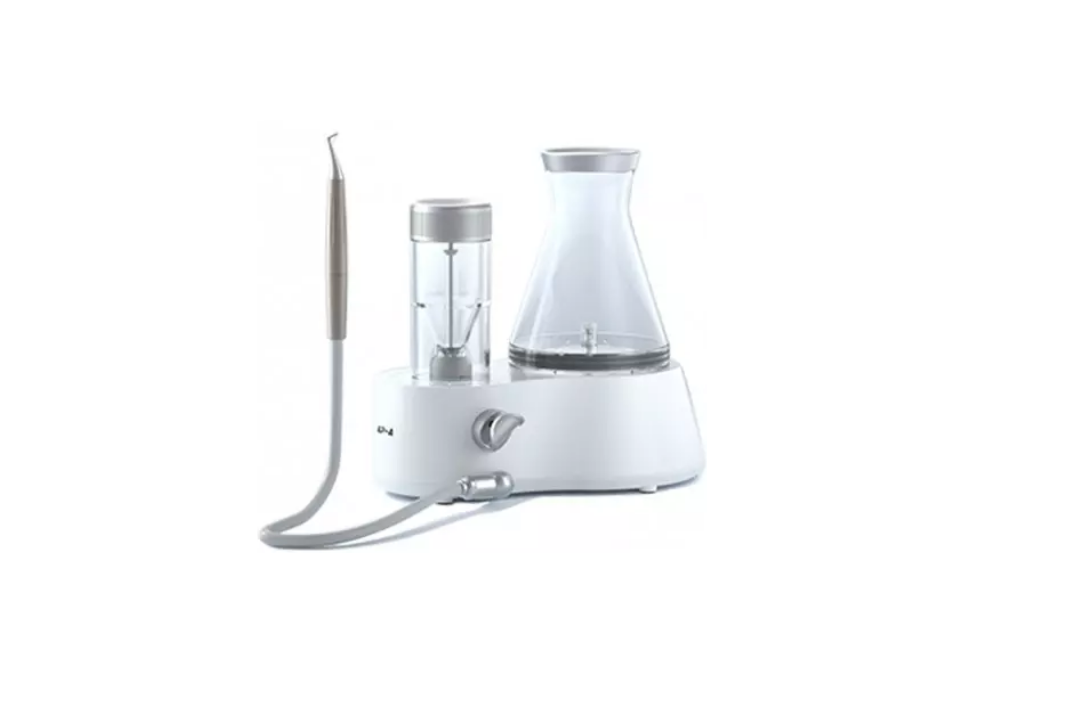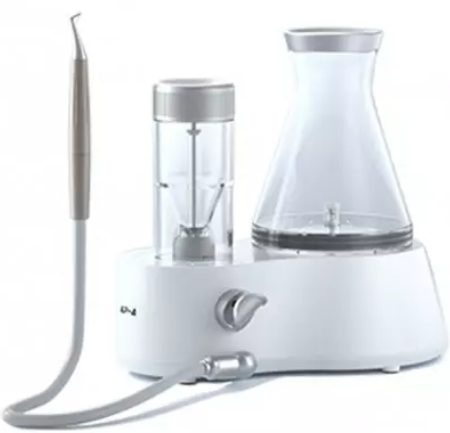Woodpecker AP-A Air Polisher
About Woodpecker
AP-A Dental Air polisher uses compressed air to drive the prophylaxis powder and spray water together on the tooth surface to remove the attachments on the tooth surface (such as dental plaque, pigment, soft dirt, etc.),
Preface
Guilin Woodpecker Medical Instrument Co., Ltd is a professional manufacturer researching, developing, and producing dental products. Woodpecker owns a sound quality control system and two brands, Woodpecker and DTE.
Its main products include a dental scaler, dental air polisher, Ultrasurgery, root canal motor, Curing light, dental implant unit, endo motor, etc.
the features of this device are as follows:
- Water and power can be adjusted.
- The handpiece is designed in three sections, it’s easy to assemble and disassemble, and easy to clean.
- The handpiece can be free to plug and can be sterilized in an environment of 134°C and 0.22MPa pressure.
Installation and Operation
The main unit and main accessories display
Front view of the main unit
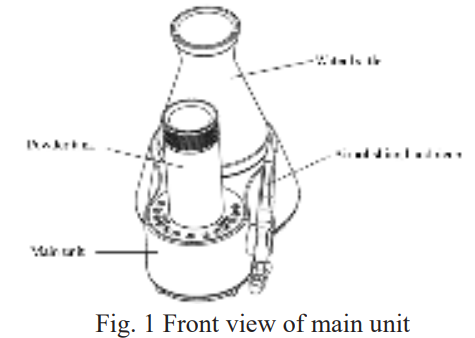
Back view of the main unit
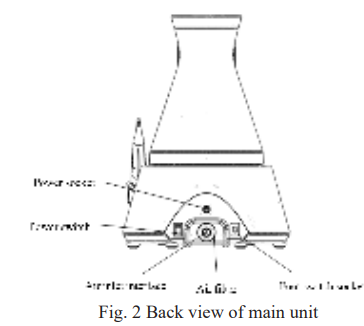
Touch panel
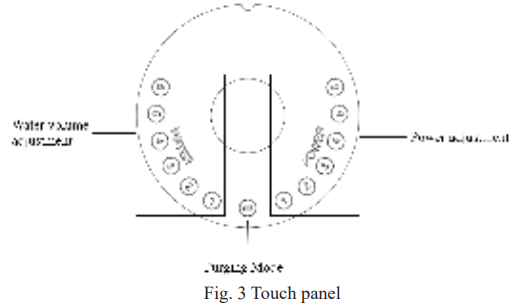
After powering on, the button will be blue. If there is no air connection or the air pressure is insufficient, the blue light flashes.
Schematic diagram of handpiece
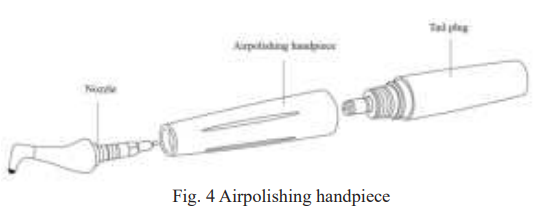
Main unit installation
- Open the package, check whether all the accessories of this device are complete according to the packing list, and put the main unit on the stable desktop for the operator.
- Take out the foot switch and insert the connector into the corresponding foot switch socket on the back of the main unit.
- Take out the external air pipe and connect the air pipe joint with the air inlet interface on the back of the main unit.
- Put the power switch in the off state, insert the output plug of the power adapter into the power socket on the back of the main unit, and then insert the input plug of the power adapter into the power socket.
- Release the foot pedal, the handle can stop working, and press the power switch to shut down.
Instructions
Handpiece connection
Take out the air polishing handpiece, connect the air polishing handpiece with the air polishing line, and place the handpiece on the bracket on the right side of the main unit.
Filling with prophylaxis powder
Take out the powder tank and use the three-way syringe to blow away the residual powder. Take out the prophylaxis powder, hold the bottle, and shake it 3-5 times, then pour the powder into the powder tank. When the powder in the powder tank is used up, please click the “Purging Mode” button twice to remove the compressed air in the powder tank, and then add the powder into the powder tank. It is not allowed to add powder when in use.
Filling with water
Take out the water bottle, add purified water (or distilled water) to the water bottle, and then plug the water bottle into the main unit. A small amount of Vaseline can be applied to the seal ring at the bottom of the water bottle to lubricate the seal ring, which is convenient for the water bottle to plug.
Use the high-speed evacuation device on the dental comprehensive treatment machine to absorb the air/powder mixture reflected from the tooth surface during treatment.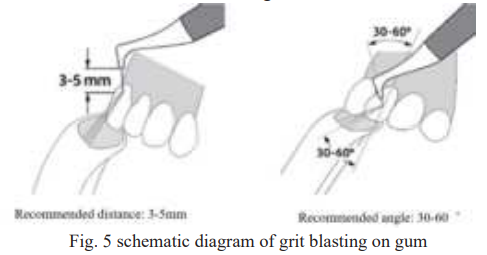
When subgingival air polishing, it’s just allowed to use sublingual powder, and misusing powder may cause harm to patients.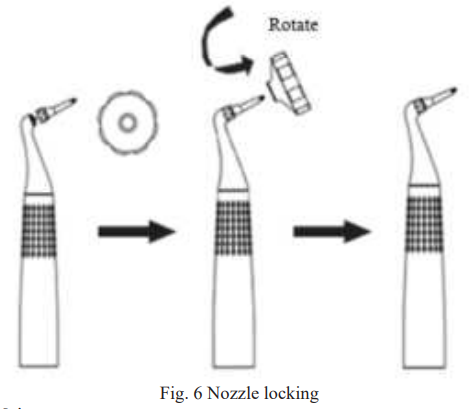
Maintenance
Air polishing handpiece
- Remove the air-polishing handpiece, loosen the handpiece head, and pull out the handpiece head (For the subgingival handpiece, the nozzle needs to be removed in advance), as shown in Fig. 7.
- Align the handpiece head with a three-way syringe and blow away the residual powder in the handpiece.
- Blow the front and rear ends of the handpiece with a three-way syringe.
- If the handpiece is blocked, use a needle to dredge it.
- Handpieces, water bottles, and powder tanks should not be maintained when they are being used.
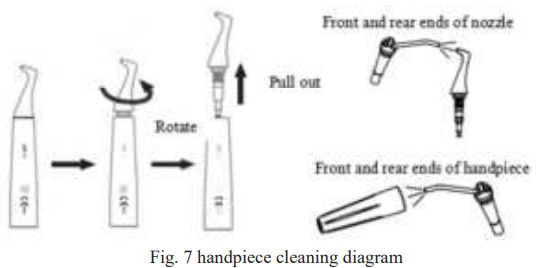
Powder tank
- It is recommended to estimate the amount of prophylaxis powder before use. It is easy to cause a block that leaves extra powder in the powder tank for a long time because the powder will clump in a humid environment. Therefore, please pour the remaining powder into the powder tank after use.
- Use a three-way syringe to clean the powder remaining in the powder tank, and blow away the powder in the thread of the powder and powder tank lid.
- Daily maintenance
Before and after using the air polishing system, please click the “purge” button on the main unit.
Troubleshooting

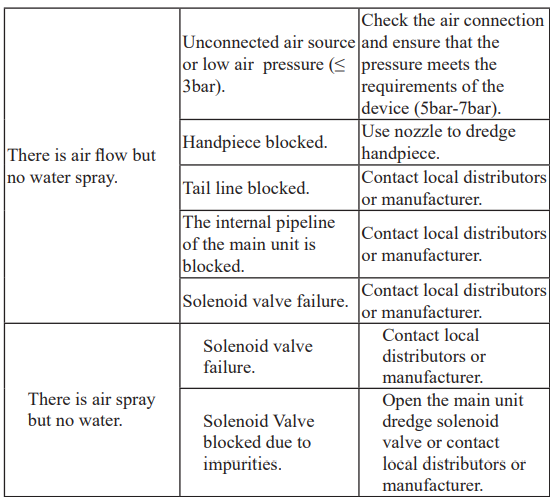
Note: Please contact your local distributor or manufacturer if the fault cannot be removed.
Cleaning, Disinfection and Sterilization
Initial processing
- Processing principles
It is only possible to carry out effective sterilization after effective cleaning and disinfection. Please ensure that, as part of your responsibility for the sterility of products during use, only sufficiently validated devices and product-specific procedures are used for cleaning/disinfection and sterilization, and that the validated parameters are adhered to during every cycle. Please also observe the applicable legal requirements in your country as well as the hygiene regulations of the hospital or clinic, especially the additional requirements for the inactivation of prions. - Post-operative treatment
The post-operative treatment must be carried out immediately, no later than 30 minutes after the completion of the operation. The steps are as follows:
Let the device work for 20-30 seconds at maximum water volume to separately flush the air-polishing handpiece and nozzle; Remove the handpieces from the device and rinse away the dirt on the surface of handpieces and their accessories with pure water (or distilled water/deionized water); Dry the handpieces and its accessories with a clean, soft cloth and place it in a clean tray.
Precautions:- The water used here must be pure, distilled water, or deionized water.
Cleaning
The cleaning of the handpiece and its accessories should be performed no later than 24 hours after the operation. The cleaning can be divided into automated cleaning and manual cleaning. Automated cleaning is preferred if conditions permit.
Automated cleaning
The cleaner is proven to be valid by FDA, CE certification, or by EN ISO 15883. There should be a flushing connector connected to the inner cavity of the product. The cleaning procedure is suitable for the handle, and the flushing period is sufficient. It is recommended to use a washer-disinfector by EN ISO 15883.
Maintenance, storage, and transportation
- It is recommended to install an air drying device (such as a freezing dryer) in advance before using air polishing device. Check the drying device every day to ensure it works normally. Otherwise, it may be easy to cause prophylaxis powder agglomerating. The agglomerating will cause the device or handpiece blocked.
- Check the sealing ring on the handpiece, tail line, powder tank, and water bottle regularly. If finding defects such as rupture, deformation, or falling off, please refer to the instructions and replace them in time, the accessories are equipped with sealing rings of corresponding specifications.
- Check the air inlet interface filter once a month to confirm whether there is an impurity in the filter. If there is impurity, replace the filter in time, and check the cleanliness of the air compressor and the environment where it is located. If there is no impurity, it is recommended to replace the filter every 24 months. Spare filters are included in accessories. The way to replace the filter is shown in Figure 8.
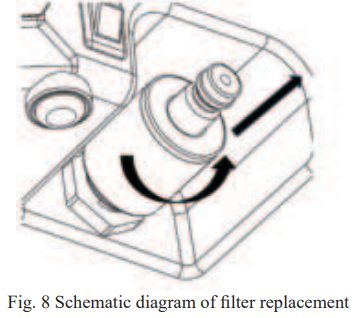
Storage
- This device should be carefully placed away from the source and should be installed or stored in a cool, dry, and ventilated place.
- Do not mix with toxic, corrosive, flammable, or explosive articles during storage.
- The product should be stored in an environment where the relative humidity is 10% ~ 93%, the atmospheric pressure is 70kPa ~ 106kPa, and the temperature is -20°C ~ + 55°C.
- When this device is not in use for a long time, it should be powered on and ventilated once a month, at least five minutes each time.
Transportation
- Excessive impact and shaking should be prevented during transport. Lay it carefully and lightly.
- Do not put it together with dangerous goods during transport.
- Avoid being exposed to sun, rain, and snow during transport.
Environment protection
Please discard waste, debris, and expired machines or components by local regulations.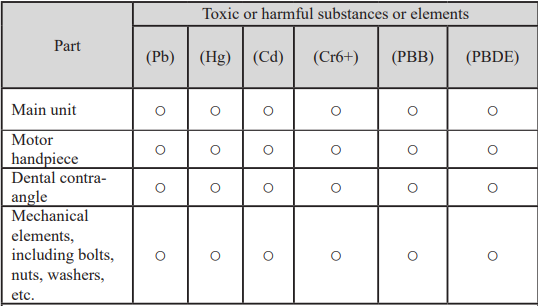
- ○: Indicates that the content of the toxic substance in all homogeneous materials of the part is below the limit requirement stipulated in SJ/T-11363- 2006 Limit Requirements for Toxic and Hazardous Substances in Electronic Information Products.
- ×: indicates that the content of the toxic substance in at least one of the homogeneous materials of the part exceeds the limit requirement specified in SJ/T-11363-2006. Please dispose according to the local laws or consult with the dealer from whom you purchased it about waste disposal.
After service
We offer one-year free repair to the device according to the warranty card. The repair of the device should be carried out by a professional technician. We are not responsible for any irretrievable damage caused by non-professional persons. This product is a precision device.
If there is a problem that needs to be repaired, returned to Woodpecker or handled by professionals is recommended. If any part needs to be replaced, please contact Woodpecker for relevant information. Please use accessories or parts provided or approved by Woodpecker. Using other accessories or parts may cause equipment failure and unacceptable risks.
Symbol instruction
![]()
- Follow Instructions for Use
- Date of manufacture
- Type B applied part
- Handle with care
- Ordinary device
- Used indoor only
- Alternating current
- Protective earthing
- Power Switch
- Direct current
- Appliance compliance WEEE directive

- Storage condition, humidity limit: 10% ~ 93%
- Storage condition, air pressure limit: 70kPa ~ 106kPa
- Storage condition, temperature limit: -20°C ~ +55°C

- CE marked product
- Manufacturer
- Recovery
- Keep dry
- Anti-drip device
- Purging mode
- Footswitch
- Sterilization under high temperature
- 30V DC
- Cooling water or flushing water
Declaration of conformity
A list of all cables are replaceable by the RESPONSIBLE ORGANIZATION :
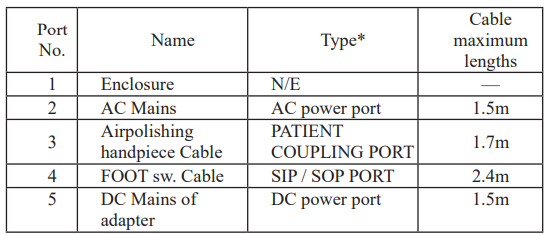

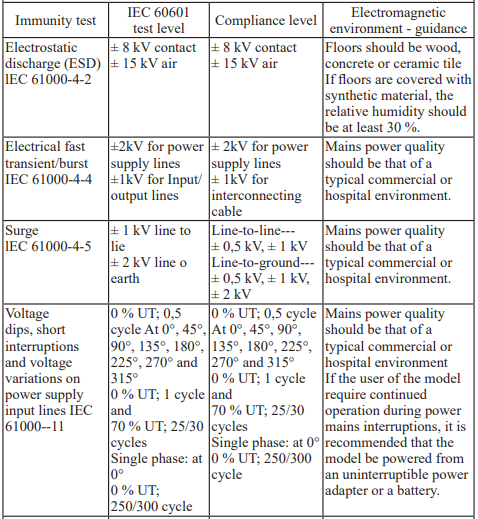

Statement
Woodpecker reserves the right to change the design of the device, the technique, fittings, the instruction manual, and the content of the original packing list at any time without further notice.
The pictures are only for reference. The final interpretation rights belong to Guilin Woodpecker Medical Instrument Co., Ltd. The appearance of the product was authorized patent, and counterfeit will be sued! (Please refer to the packaging label for the date of manufacture. Service life: 10 years)
Scan and Login website for more information

Guilin Woodpecker Medical Instrument Co., Ltd. Information Industrial Park, Guilin National High-Tech Zone, Guilin, Guangxi, 541004 P. R. China
Sales Dept.: +86-773-5873196
http://www.glwoodpecker.com
E-mail: woodpecker@glwoodpecker.com
MedNet EC-Rep GmbH
Borkstrasse 10 • 48163 Muenster • Germany
FAQs About Woodpecker AP-A Air Polisher
When employing the air polisher What exactly is abrasive?
Sodium bicarbonate which has been carefully treated is the most popular abrasive particle for air polishing (SPSB). To keep it free flowing, small amounts of silica and calcium phosphate are added to food-grade tribasic SPSB.
Does air polishing work well?
Air polishers are more successful at eliminating stains than polishing cups are. Plaque and stains that could obstruct the view during scaling are lessened by using air polishers before scaling, particularly if biofilm levels are high.
Can an implant be air-polished?
In air-polishing therapy, water, pressurized air released from the device, and low-abrasive powders cause abrasion at the implant surface, which removes the biofilm.
Can stains be removed by airflow?
In addition, AirFlow helps remove more serious stains that may result from medications as well as stains produced by a genetic predisposition to darker teeth.
Why would someone need an air polisher handpiece?
Adult patients benefit greatly from air cleaning, as is widely recognized. Air polishing is beneficial for removing biofilm, cleaning around implants, and easily erasing even the toughest tobacco stains. However, keep in mind that they might be a useful supplement to pediatric dental care.
Is hand polishing effective?
Efficiency, To be honest, machine polishing is more effective than hand polishing. To more uniformly and efficiently abrade the clear coat and produce more consistent results, machines are moving faster.
Does airflow promote dental health?
In addition to being the finest treatment now available for treating and managing gum disease, or periodontal disease, airflow therapy is also a terrific approach to maintain your oral health and dental hygiene. It’s also a terrific last-minute solution for important events like weddings, holidays, and job interviews.
Does tartar get removed by air polishing?
As the name Air Polish suggests, this procedure cleans your teeth by splattering air jets over their surface. In addition to being painless, this procedure works far faster than the conventional scale and polish method, destroying calculus buildup, tartar, and plaque with ease.
How much time does toothpolish last?
This operation should ideally be done at least once every three months. Although polishing makes teeth appear whiter and better, you may choose to only have polishing done twice a year if your teeth are in good condition following the scaling treatment.
Why would someone need an air polisher handpiece?
Adult patients benefit greatly from air cleaning, as is widely recognized. Air polishing is beneficial for removing biofilm, cleaning around implants, and easily erasing even the toughest tobacco stains. However, keep in mind that they might be a useful supplement to pediatric dental care.
For more Manuals by Woodpecker, visit MANUALSDOCK

